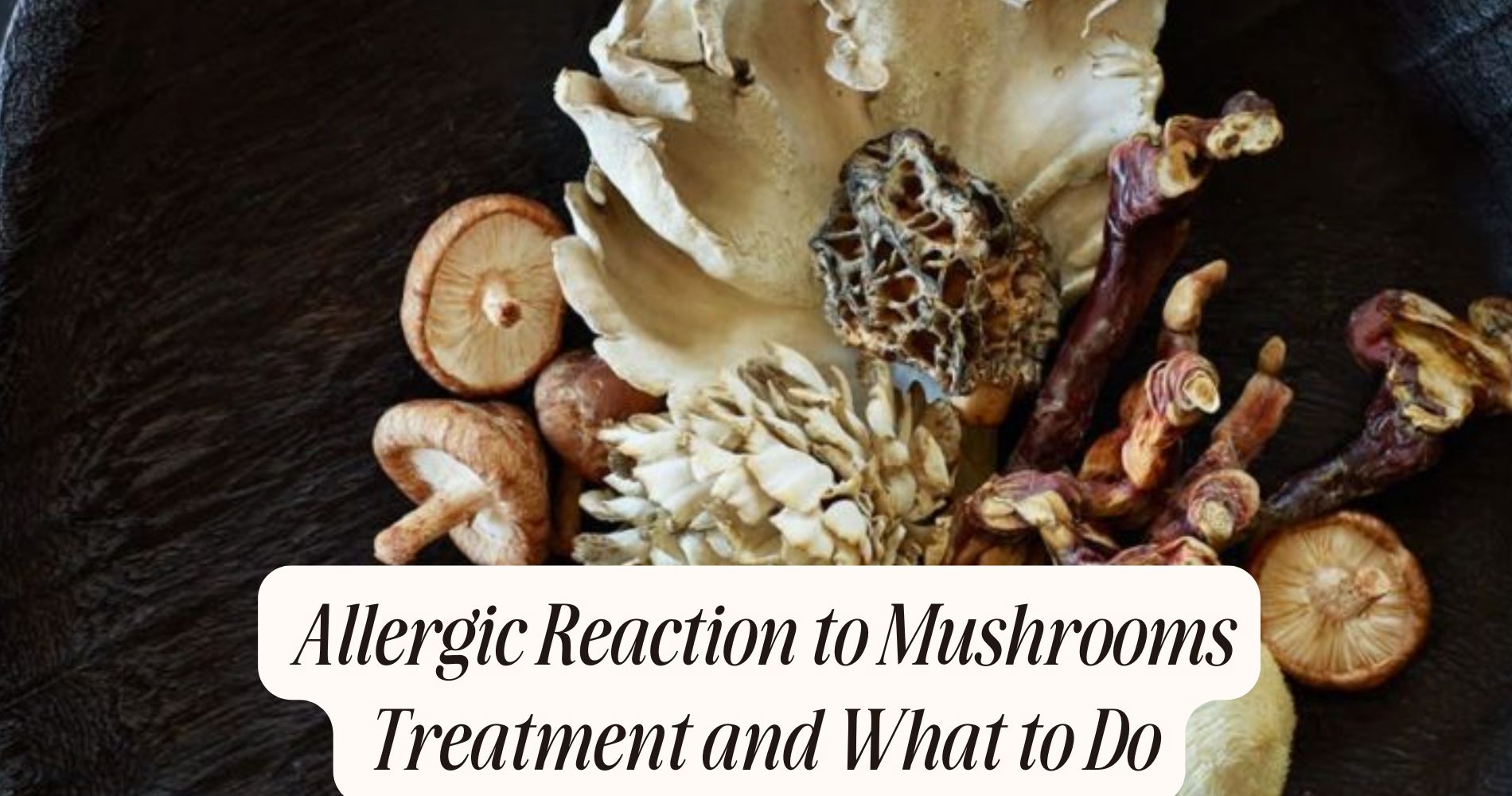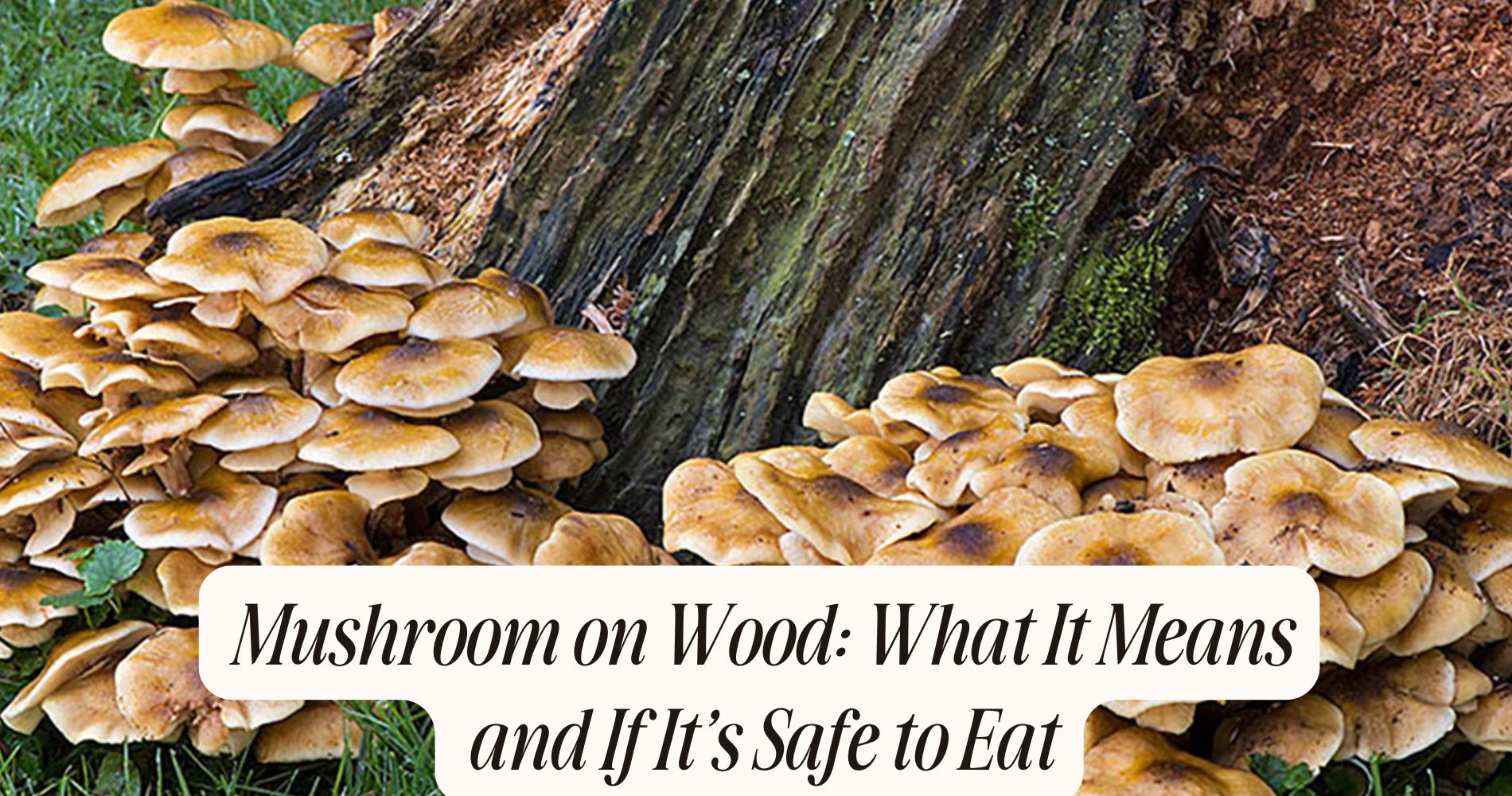
Allergic Reaction to Mushrooms Treatment and What to Do
When it comes to allergic reaction to mushrooms treatment, quick action is essential. If symptoms appear, immediately remove the source and, for mild reactions, use over-the-counter antihistamines and apply cool compresses to reduce discomfort. In more severe cases, administer an epinephrine auto-injector right away and seek emergency medical help. Long-term treatment involves identifying your specific triggers, avoiding all mushroom varieties, and consistently carrying allergy medication. It's also important to inform others about your allergy, especially when dining out. Continue reading for detailed strategies to manage mushroom allergies safely and effectively.
Understanding Mushroom Allergies
Although many people enjoy mushrooms for their taste and nutritional benefits, some individuals may develop an allergic reaction to them. Understanding mushroom classification is vital, as different types can trigger varying immune responses.
Fungi are broadly categorized into edible, toxic, and medicinal mushrooms, but allergens can exist in any category. The proteins in these fungi may provoke an allergic reaction in sensitive individuals. This can occur due to cross-reactivity with other allergens, such as pollen or molds.
Identifying specific mushroom species is essential for those at risk, as reactions can range from mild to severe. Being aware of your own sensitivities and the mushroom classification can help you make informed dietary choices to avoid potential allergic reactions.
Common Symptoms of Mushroom Allergies
If you have a mushroom allergy, you might experience various symptoms that can affect your skin, respiratory system, and gastrointestinal tract.
Skin reactions like rashes or hives are common, while respiratory issues may include coughing or wheezing.
Additionally, gastrointestinal distress can manifest as nausea, vomiting, or diarrhea.
Skin Reactions and Rashes
When you have an allergic reaction to mushrooms, skin reactions and rashes often emerge as common symptoms. You may notice skin irritations like hives, redness, or swelling shortly after exposure.
These reactions can vary in severity, ranging from mild irritation to extensive rashes covering larger areas of your skin.
For effective rash treatments, begin by washing the affected area with soap and water to remove any mushroom residue. Over-the-counter antihistamines can help alleviate itching and discomfort.

Topical corticosteroids might be recommended to reduce inflammation. If your skin reactions worsen or persist, consult a healthcare professional for further evaluation and treatment options.
Staying vigilant about food labels and avoiding mushrooms entirely can prevent future allergic responses.
Respiratory Issues and Symptoms
Respiratory issues can arise quickly after exposure to mushrooms, leading to a range of symptoms that may indicate an allergic reaction. Common respiratory complications include sneezing, nasal congestion, and coughing.
You might also experience wheezing or shortness of breath, which can signify a more severe response. These symptoms typically occur due to allergic triggers present in mushroom spores or proteins.
If you notice difficulty breathing, it’s vital to seek medical attention immediately, as this could escalate to anaphylaxis. Avoiding mushrooms entirely is essential in preventing future reactions.
Identifying specific triggers through allergy testing can help pinpoint which mushroom varieties to avoid, ensuring your safety and well-being in environments where mushrooms are present.
Gastrointestinal Distress Indicators
Gastrointestinal distress is another common reaction to mushroom allergies, often manifesting shortly after consumption.
You might experience various gastrointestinal symptoms, including nausea, vomiting, abdominal cramps, and diarrhea. These digestive issues can vary in severity, leading to discomfort and potential dehydration if not managed properly.
It’s essential to recognize these indicators promptly, as they can escalate quickly. If you notice these symptoms following mushroom ingestion, you should seek medical attention to assess the severity of your reaction.
Monitoring your symptoms closely can aid in identifying specific triggers and preventing future exposure. Always consult with a healthcare professional for personalized advice and treatment options tailored to your needs, especially if you suspect a mushroom allergy.
Diagnosis of Mushroom Allergies
To diagnose mushroom allergies, you'll first need to recognize the symptoms, which can vary from mild to severe.
Allergy testing methods, such as skin prick tests or blood tests, help confirm your sensitivity to specific mushroom proteins.
These steps are essential in determining the right approach for treatment and management.
Symptoms of Mushroom Allergies
Mushroom allergies can trigger a range of symptoms that vary from mild to severe, making it essential to recognize them promptly.
You might experience skin reactions like hives or rashes, digestive issues such as nausea or diarrhea, and respiratory problems including sneezing or difficulty breathing.
Some individuals may also face anaphylaxis, a life-threatening reaction requiring immediate attention.

Different mushroom types can provoke distinct allergic responses, and there’s a possibility of allergy cross reactivity with other fungi or allergens.
Be aware that symptoms can emerge shortly after exposure or may take hours to develop.
Identifying these signs early can help you manage your health effectively and avoid severe reactions in the future.
Allergy Testing Methods
When experiencing symptoms of a potential mushroom allergy, accurate diagnosis is essential for effective management.
Allergy testing methods help identify specific triggers. One common method is the skin prick test, where a small amount of mushroom extract is applied to your skin. If you're allergic, you'll develop a localized reaction, indicating sensitivity.
Another approach is blood tests, which measure the presence of specific antibodies (IgE) in your bloodstream. These tests can provide a broader assessment of your allergy profile.
Consult with an allergist to determine which testing method is best for you.
Early diagnosis can guide you in avoiding allergens and managing your symptoms effectively, ensuring a safer and healthier lifestyle.
Immediate Treatment for Mild Reactions
Allergic reactions to mushrooms can vary in severity, but immediate treatment for mild reactions is essential to prevent worsening symptoms.
If you experience mild symptoms like hives or itching, first, remove any mushroom triggers from your environment. Over-the-counter antihistamines, such as diphenhydramine, can help relieve itching and swelling. You can also apply a cool compress to affected areas for comfort.
Home remedies like aloe vera gel can soothe irritated skin. Staying hydrated is important too, as it helps flush allergens from your system.
Always be cautious and avoid triggers in the future to prevent recurrence. If symptoms persist or worsen, consult a healthcare professional for further guidance.
Emergency Treatment for Severe Reactions
If you experience severe symptoms after consuming mushrooms, recognizing them promptly is essential.
These symptoms can include difficulty breathing, swelling, or rapid heartbeat.
Administer emergency medications, such as an epinephrine auto-injector, immediately to counteract the reaction.
Recognizing Severe Symptoms
Recognizing severe symptoms of a mushroom allergy is vital for prompt emergency response. Different mushroom types can trigger various allergic reactions, so knowing the signs is important.
If you experience difficulty breathing, swelling of the face or throat, rapid heartbeat, or dizziness after consuming mushrooms, seek immediate medical attention. Hives, severe abdominal pain, or vomiting may also indicate a severe reaction.

It’s important to monitor for anaphylaxis, a life-threatening condition that can develop quickly. Other allergy triggers, such as cross-reactivity with other foods or environmental factors, can complicate the situation.
Always err on the side of caution; when in doubt, call emergency services to guarantee your safety and well-being.
Administering Emergency Medications
When faced with severe allergic reactions to mushrooms, administering emergency medications promptly can be life-saving. If symptoms like difficulty breathing, swelling, or rapid heartbeat arise, you should use an auto-injector to deliver epinephrine immediately.
Follow dosage guidelines: for adults, administer 0.3-0.5 mg (0.3-0.5 mL of a 1:1000 solution), while children typically require 0.01 mg per kg, not exceeding 0.3 mg. Inject the epinephrine into the outer thigh, through clothing if necessary.
After administering, seek emergency medical help, even if symptoms improve. Remember, you might need a second dose if symptoms persist, so stay alert.
Always consult your healthcare provider for personalized advice on managing severe allergic reactions and carrying epinephrine.
Medications for Mushroom Allergies
Although mushroom allergies can vary in severity, effective medications are available to manage symptoms and reduce discomfort.
Antihistamines, like cetirizine and loratadine, can relieve itching, sneezing, and hives. For more severe reactions, corticosteroids may be prescribed to reduce inflammation and swelling. If you experience anaphylaxis, carrying an epinephrine auto-injector is vital for emergency treatment.
Additionally, over-the-counter options, such as topical creams, can alleviate localized skin irritation. It’s important to consult your healthcare provider to determine the best medication options tailored to your needs.
Long-term Management and Prevention
To effectively manage mushroom allergies in the long term, it’s vital to identify and avoid triggers within your diet and environment.
Implementing long-term avoidance strategies is important; this includes avoiding all mushroom varieties and thoroughly reading food labels.
Participate in allergy education programs to enhance your understanding of mushroom allergens and their potential sources. Educating yourself about cross-contamination in restaurants and grocery stores can further reduce risks.
Consider carrying an epinephrine auto-injector if your reactions are severe. Regular consultations with an allergist can help you stay informed about new developments in allergy management.
Identifying Safe Mushroom Varieties
Identifying safe mushroom varieties is essential for anyone with a mushroom allergy, as even a small amount can trigger a reaction.
To guarantee safe mushroom identification, familiarize yourself with common edible mushroom varieties like button, cremini, and shiitake. Always consult reliable resources or experts when foraging or purchasing mushrooms.

Remember that some mushrooms have toxic look-alikes, so relying solely on visual characteristics isn't enough. If you're unsure about a mushroom's safety, it's best to avoid it altogether.
When shopping, look for certified organic or commercially cultivated options, as these are less likely to be harmful.
Tips for Dining Out and Eating Safely
When dining out, being proactive about your mushroom allergy is essential to guarantee a safe experience. Start by making dining precautions a priority.
Before entering the restaurant, review the menu online to spot any potential mushroom dishes. Once seated, don’t hesitate to make menu inquiries. Ask the server about mushroom usage in sauces or mixed dishes, as they may not be listed.
Specify your allergy clearly to make certain they understand the severity. Choose simple dishes with fewer ingredients to minimize risk. If you're unsure about a dish, opt for something else.
It's wise to carry your allergy medication, just in case. Being vigilant helps you enjoy your meal without worrying about a potential allergic reaction.
When to Seek Medical Help
If you experience symptoms of an allergic reaction after consuming mushrooms, don’t hesitate to seek medical help.
It’s essential to know when to consult a healthcare professional. If you notice swelling, hives, difficulty breathing, or gastrointestinal distress, these may indicate a severe reaction.
Immediate attention is necessary if you experience anaphylaxis, characterized by rapid swelling of the throat, a sudden drop in blood pressure, or loss of consciousness.
Don’t wait for symptoms to escalate; seeking help promptly can be life-saving. Even mild reactions should be evaluated to prevent future incidents.
Always inform your doctor about your mushroom allergy for appropriate management and guidance. Your safety and health should always be your top priority.
Gentle Wellness for Sensitive Systems: SUPER MUSHROOM GUMMIES
Concerned about sensitivities and searching for a safer way to enjoy mushroom benefits? While exploring allergic reaction to mushrooms treatment, consider Well Gummies' SUPER MUSHROOM GUMMIES—a carefully crafted, vegan-friendly option that offers the goodness of 10 functional mushrooms in a gentle, convenient form. Designed to support immune health, focus, and natural energy, these gummies come with a delicious wild berry flavor and no harsh side effects, jitters, or crash. Ideal for those seeking balance without compromise—Well Gummies makes wellness simple and satisfying.
Frequently Asked Questions
Can Children Develop Mushroom Allergies Too?
Yes, children can develop mushroom allergies due to childhood allergies and mushroom exposure. Early contact with mushrooms can trigger allergic reactions, so it’s crucial to monitor your child’s response if they consume mushrooms for the first time.
Are There Any Natural Remedies for Mushroom Allergies?
You might consider herbal treatments like stinging nettle or chamomile, which can help alleviate symptoms. Additionally, dietary supplements such as quercetin and vitamin C may support your immune system and reduce allergic reactions. Always consult a professional first.
What Foods Should I Avoid Besides Mushrooms?
Besides mushrooms, you should avoid foods containing similar allergens like truffles or certain fungal products. Opt for allergy-safe ingredients such as vegetable-based mushroom substitutes, ensuring your meals remain flavorful without risking allergic reactions.
How Can I Tell if Mushrooms Are Safe to Eat?
To determine if mushrooms are safe to eat, focus on accurate mushroom identification. Research edible species, use reliable guides, and consult experts. Always trust your instincts—if unsure, don’t consume them. Safety's paramount!
Is It Possible to Outgrow a Mushroom Allergy?
Yes, it’s possible to outgrow a mushroom allergy. You might notice reduced mushroom allergy symptoms over time. Regular mushroom allergy testing can help determine your current sensitivity and guide your dietary choices effectively.
Conclusion
In summary, if you suspect a mushroom allergy, it’s essential to recognize symptoms early and seek appropriate treatment. For mild reactions, over-the-counter antihistamines can help, while severe cases require immediate medical attention. Long-term management involves avoiding known allergens and understanding safe mushroom varieties. Always communicate your allergy when dining out and stay vigilant. By taking these steps, you can effectively manage your mushroom allergy and enjoy safe eating experiences.




